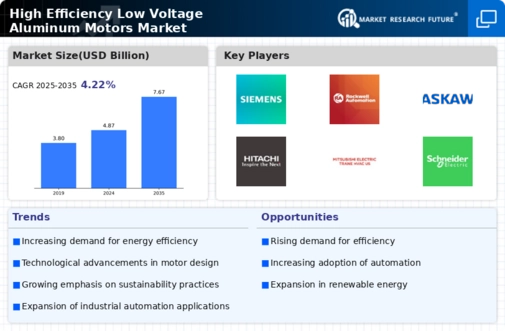Market Growth Projections
Projected growth figures for the Global High Efficiency Low Voltage Aluminum Motors Market Industry indicate a promising future. The market is expected to reach 4.87 USD Billion in 2024 and is anticipated to grow to 7.67 USD Billion by 2035. This growth trajectory suggests a compound annual growth rate (CAGR) of 4.22% from 2025 to 2035. Such metrics underscore the increasing importance of high-efficiency motors in various applications, driven by factors such as energy efficiency, regulatory support, and technological advancements. The market's expansion reflects a broader trend towards sustainable industrial practices.
Technological Advancements
Technological innovations are significantly influencing the Global High Efficiency Low Voltage Aluminum Motors Market Industry. Advancements in materials, design, and manufacturing processes have led to the development of motors that offer superior performance and efficiency. For example, the integration of smart technologies enables real-time monitoring and optimization of motor operations. This not only enhances energy savings but also extends the lifespan of the equipment. As industries increasingly adopt these advanced solutions, the market is expected to witness a compound annual growth rate (CAGR) of 4.22% from 2025 to 2035, indicating a robust trajectory for high-efficiency motors.
Rising Industrial Automation
The trend towards industrial automation is a significant driver for the Global High Efficiency Low Voltage Aluminum Motors Market Industry. As industries seek to enhance productivity and reduce labor costs, the demand for automated systems is on the rise. High-efficiency motors are integral to these systems, providing reliable and energy-efficient operation. The increasing adoption of robotics and automated machinery across various sectors, including automotive and food processing, further propels the market. This shift not only improves operational efficiency but also aligns with sustainability goals, thereby reinforcing the market's growth potential.
Expansion in Emerging Markets
Emerging markets are presenting new opportunities for the Global High Efficiency Low Voltage Aluminum Motors Market Industry. Countries in Asia-Pacific and Latin America are witnessing rapid industrialization and urbanization, leading to increased demand for energy-efficient solutions. As these regions invest in infrastructure development and modernization of industrial facilities, the adoption of high-efficiency motors is likely to rise. This trend is supported by government initiatives aimed at promoting sustainable practices. Consequently, the market is poised for substantial growth, with projections indicating a potential increase to 7.67 USD Billion by 2035.
Regulatory Support and Standards
Regulatory frameworks play a crucial role in shaping the Global High Efficiency Low Voltage Aluminum Motors Market Industry. Governments worldwide are implementing stringent regulations to promote energy efficiency and reduce greenhouse gas emissions. For instance, initiatives such as the Energy Independence and Security Act in the United States encourage the use of high-efficiency motors. Compliance with these regulations not only enhances operational efficiency but also provides manufacturers with a competitive edge. As a result, the market is likely to benefit from increased investments in high-efficiency technologies, contributing to its projected growth to 7.67 USD Billion by 2035.
Growing Demand for Energy Efficiency
The Global High Efficiency Low Voltage Aluminum Motors Market Industry is experiencing a notable increase in demand for energy-efficient solutions. As industries strive to reduce operational costs and minimize environmental impact, the adoption of high-efficiency motors becomes essential. In 2024, the market is projected to reach 4.87 USD Billion, reflecting a shift towards sustainable practices. This trend is particularly evident in sectors such as manufacturing and HVAC, where energy consumption is substantial. The emphasis on energy efficiency aligns with global initiatives aimed at reducing carbon footprints, thereby driving the market's growth.


















